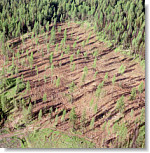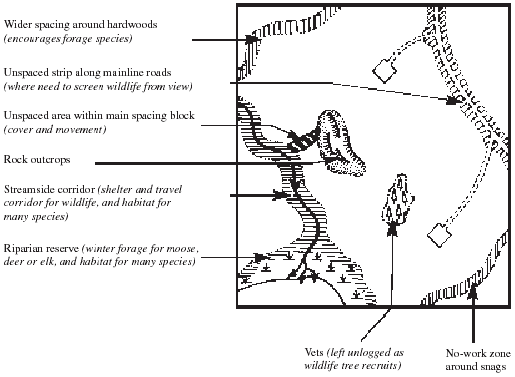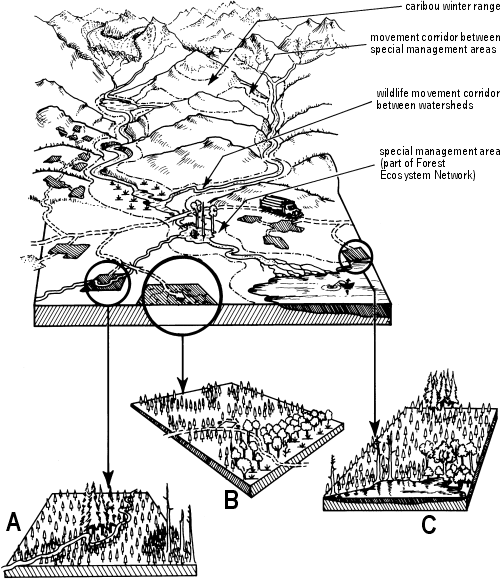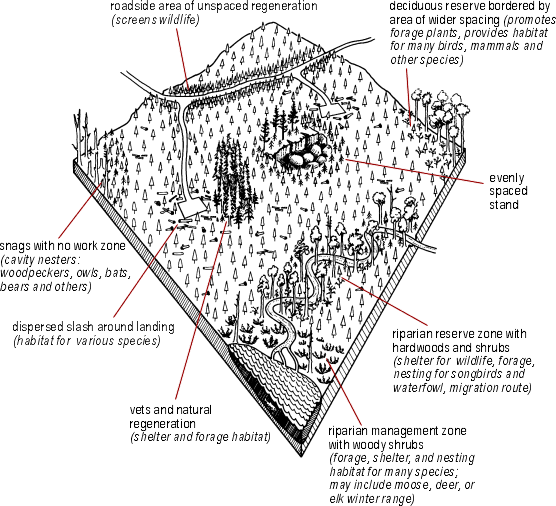6.2 General recommendations for managing for biodiversity at the stand level in silviculture practices
Are there other recommendations that you would suggest? If so, what are they?
Some vertical and spatial variability should be maintained throughout stands. Within larger stands, this can be achieved by using a combination of variable stocking densities at planting, mortality, natural infill, spacing, and thinning activities. In vegetation management or thinning treatments, patches (0.5 to 1.0 ha) or strips (30-50 m wide) can be left unthinned on some sites so that dense patches develop. Wider spacing can be used in other areas, in patches of 2 to 8 ha, to maintain a partially open canopy that will promote understorey vegetation and horizontal patchiness.
Leave patches of not sufficiently restocked (NSR) unspaced to provide diversity. Consider using clumpy spacing as a way to simulate natural stand structure. Some spacing blocks may have to be divided into a number of treatment units to fulfill different management objectives. Non-merchantable defect trees should be left as recruitment standing dead trees rather than removed. Seed trees can function as future wildlife trees and as well can provide natural regeneration. If they are maintained across rotations, large seed trees will recruit
 Do you agree with all of these recommendations? If not, why not?
Do you agree with all of these recommendations? If not, why not?
Patches of advance regeneration can provide structural diversity. Irregularly shaped openings most closely represent natural disturbance patterns. Left is a picture of seed trees in Cranbrook.
Workers are permitted to work up to standing dead trees maintained on harvest blocks in low ground vibration silviculture activities (planting, brushing, pruning, juvenile spacing) if they have first been assessed by a qualified wildlife/danger tree assessor and the necessary safety procedures have been applied (Figure 18).
Examples of juvenile spacing treatments for maintaining biodiversity are illustrated pre and post-treatment in Figures 21, 22, 23, and 24 (adapted from Park and McCulloch, 1993).
Singletree hazard/soundness assessment procedures apply to tree planting, brushing, pruning and juvenile spacing. These diagnostic procedures are not valid in high ground vibration activities such as mechanical site prep, commercial thinning, or harvesting. Refer to the "Wildlife/Danger Tree Assessor's Course" for details on wildlife tree assessment procedure.
Figure 18. Standing dead trees that have been assessed, by a certified trained assessor, as safe can be worked around in silviculture operations

Figure 19. Perspective view of a spaced stand in which attributes that support biodiversity have been maintained or enhanced

Figure 20. Map of block after spacing survey (shows planned block)

Figure 21. Examples of juvenile spacing for the maintenance of biodiversity set in the context of an overall landscape plan

Figure 22. Perspective view of a spaced stand in which attributes that support biodiversity have been maintained or enhanced




